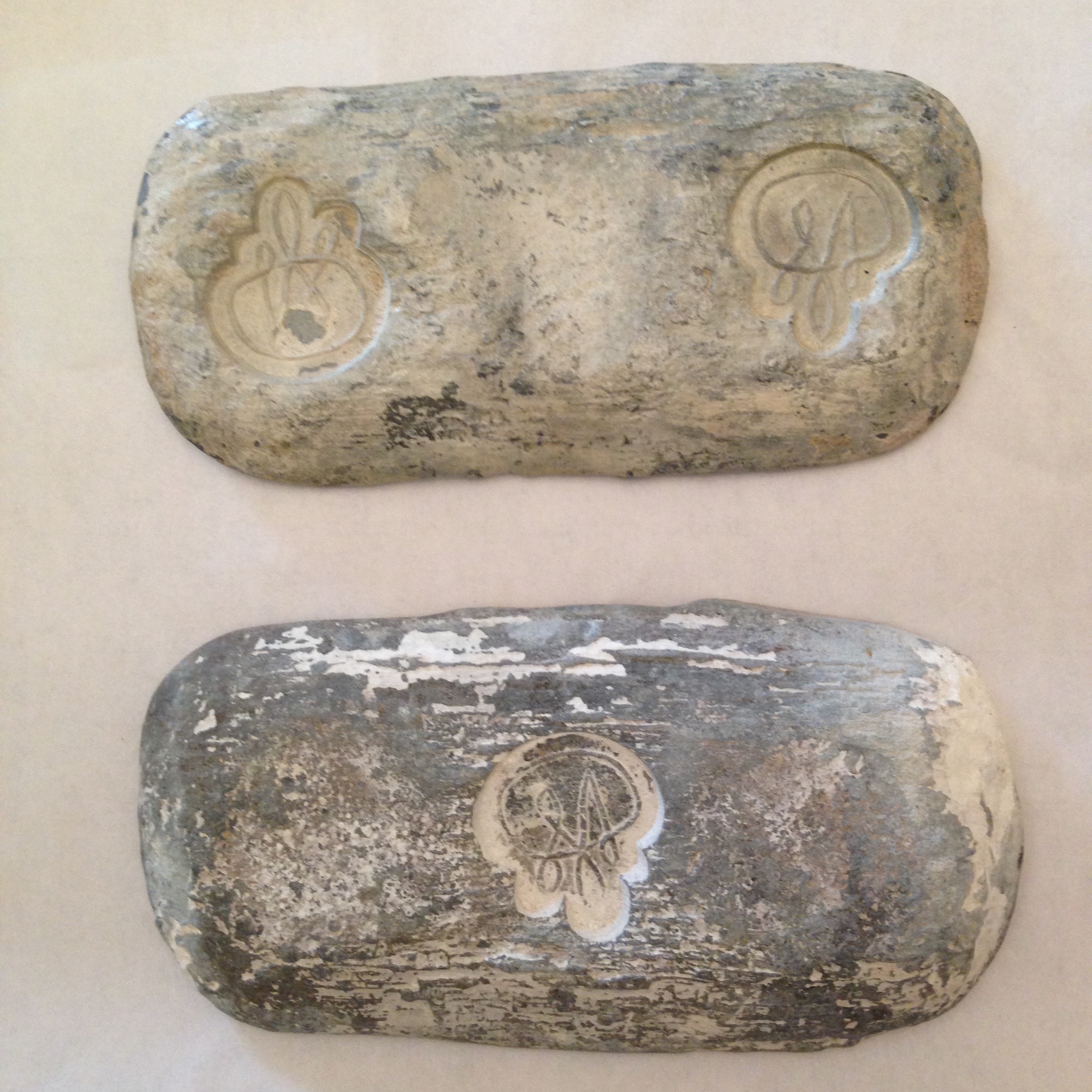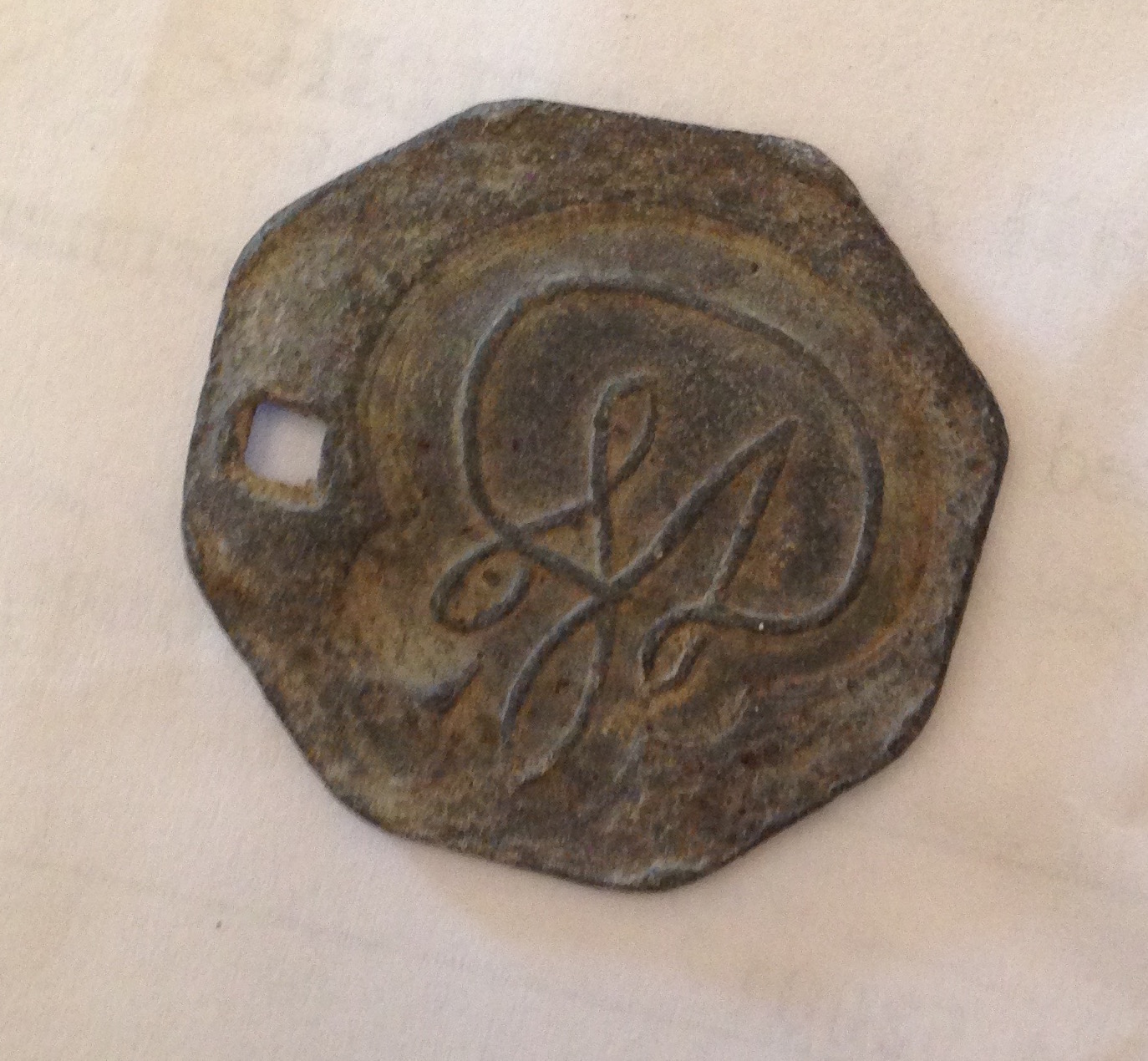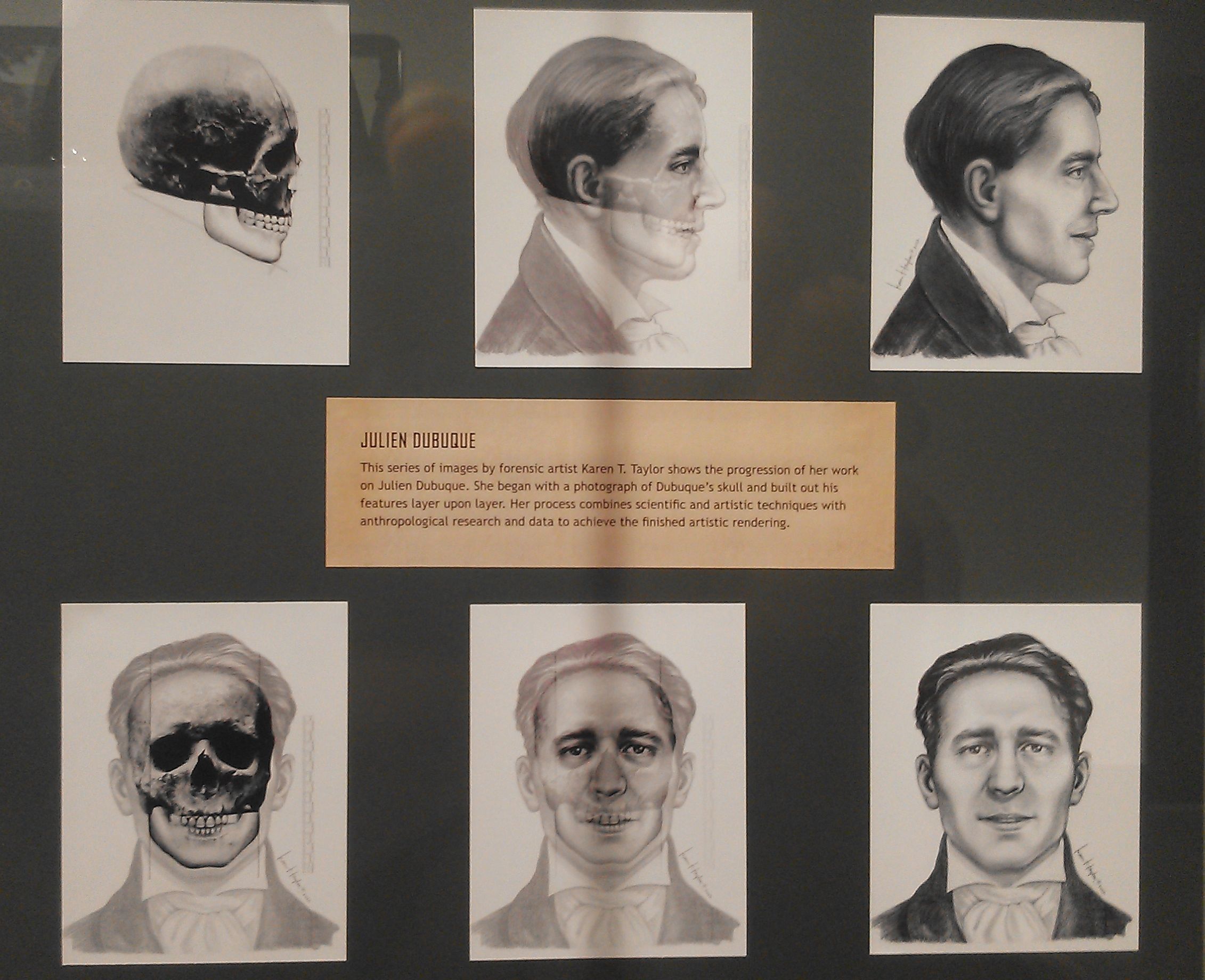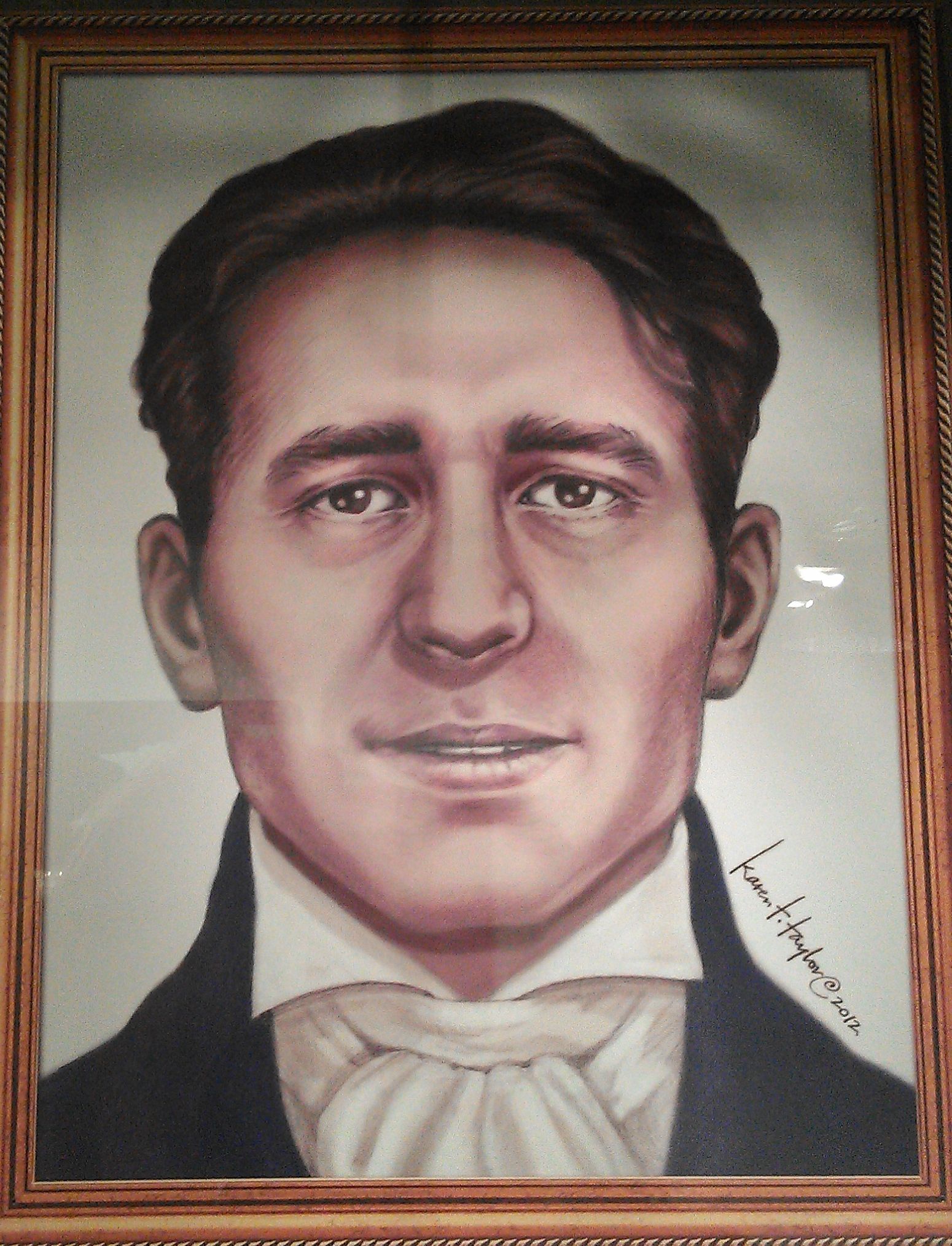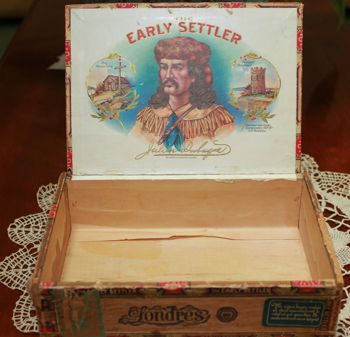Encyclopedia Dubuque
"Encyclopedia Dubuque is the online authority for all things Dubuque, written by the people who know the city best.”
Marshall Cohen—researcher and producer, CNN
Affiliated with the Local History Network of the State Historical Society of Iowa, and the Iowa Museum Association.
DUBUQUE, Julien
Family History: http://wc.rootsweb.ancestry.com/cgi-bin/igm.cgi?op=GET&db=:2731344&id=I3411
DUBUQUE, Julien. (St. Pierre les Becquets, Canada, Jan. 10, 1762--western shore of the MISSISSIPPI RIVER, Mar. 24, 1810). Julien Dubuque was the youngest of possibly ten children born to Noel-Augustin and Marie (Mailhot) Dubuque. (1) He was well educated in the parish schools and was fluent in English and French. He was also apparently able to play the fiddle and had an interest in culture and the arts.
He worked as a clerk out of Michilimackinac learning the Indian trade. Dubuque, for whom the city in Iowa is named, traveled toward the site of his future home in 1783 after hearing of rich deposits of LEAD in the region. (2) Following the St. Lawrence River through the Great Lakes, he is believed to have journeyed through the Fox River valley and down the Wisconsin River to join his brother Augustin at Prairie du Chien.
Traveling down the Mississippi, Dubuque settled among the MESKWAKIES close to the village of Kettle Chief just south of where the JULIEN DUBUQUE MONUMENT now stands. On September 22, 1788 in Prairie du Chien, Dubuque made an agreement with the Meskwakies under the leadership of Aquoqua to work the lead mines on their land. (3) After obtaining permission to mine, Dubuque brought ten French-Canadians from Prairie du Chien to assist him as boatmen, overseers, smelters and wood choppers. (4) He often used members of the tribe to prospect for new MINING sites and frequently sent halfbreeds or Canadians to do the actual labor.
He was not above using trickery to obtain his goals.
The most popular tradition which has come down to us
is that on one occasion when the Indians refused to
accede to some demand, he threatened to set Catfish
Creek on fire, and leave their village high and dry.
They still denied him; so one night his associates
emptied a barrel of oil—or turpentine—on the water,
above the bend, and when it had floated down to the
village, Dubuque set fire to it. In a few moments the
entire creek was apparently in a blaze. The terrified
Indians made haste to concede all Dubuque had asked—and
supposedly by the exercise of his will, the fire went
out. (5)
Feeling less than secure in the legality of his claim, Dubuque petitioned the Spanish governor general, Baron de Cardondolent, in 1796 for a clear title. (6) His claim then stretched approximately twenty-one miles along the river and nine miles inland. (7) The governor granted Dubuque claims to the MINES OF SPAIN with the understanding that no trade could be carried out with the Native Americans of the region without the permission of Andrew Todd, an Irish trader with influence among the Spanish officials. (8) Dubuque was not to be bothered for long by this restriction. Todd died of yellow fever soon after the agreement was signed.
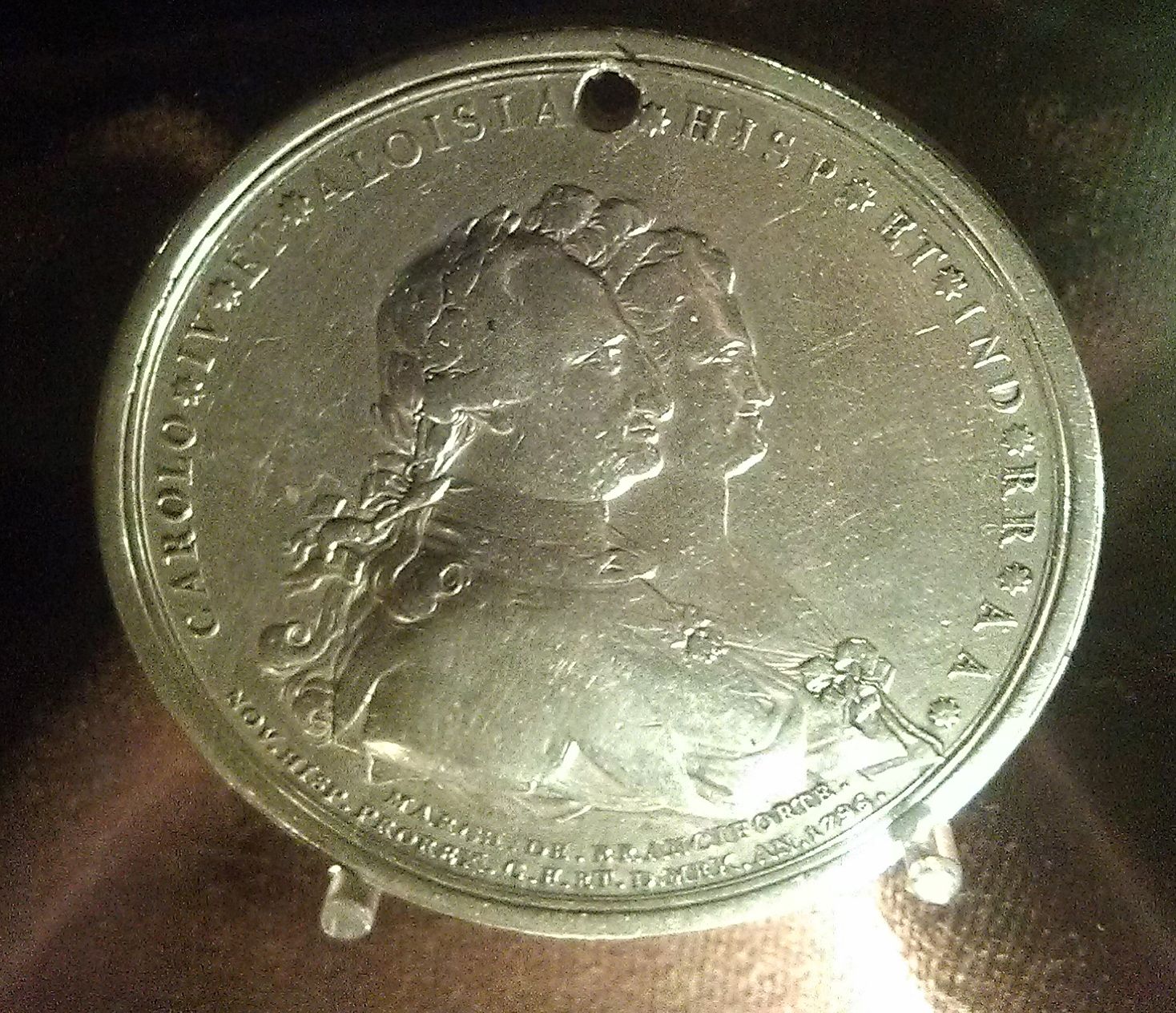
Dubuque's claim may have been helped by the role he played in the rescue of Basil Giard, another of Iowa's earliest settlers. In 1795 although all the lands west of the MISSISSIPPI RIVER belonged to Spain, French trappers continued to enter the area. To counter this invasion, Spanish officials in New Orleans considered it a wise plan to have a Spanish trading post opposite Prairie du Chien. In May 1795 Giard, a trader in Prairie du Chien, paddled his canoe to New Orleans to confer with the Spanish governor. In exchange for establishing the this post, Giard was given 5,700 acres around what became McGregor, Iowa. For this Giard had to annually bring his furs to New Orleans. Hostile Native Americans soon recognized the value of the canoes headed south and attacked them. On one occasion in 1795, Giard was rescued by Julien Dubuque. (9)
At the Mines of Spain, Dubuque had cabins constructed for his French Canadian helpers, a smelting furnace, trading post, sawmill, and blacksmith shop. (10)
Dubuque enjoyed considerable fame throughout the Mississippi Valley. James G. Soulard, the son of a prominent citizen of St. Louis, has left with us perhaps the best picture obtainable of Dubuque Mr. Soulard describes Julien Dubuque, as he appeared in middle life,
as “a man below the usual stature, of black hair
and eyes, wiry and well-built, capable of great
endurance, and remarkably courteous and polite,
with all the suavity and grace of the typical
Frenchman. To the ladies he was always the essence
of politeness.”
Mr. Soulard remembered well that on the occasion of one of Dubuque’s visits, a ball was given in his honor, attended by all the prominent people of the place. "At one point of the festivities, M. Dubuque took a violin from one of the performers and executed a dance to the strains of his own music, which was considered a great accomplishment and was received with tremendous applause." (11)
Dubuque enjoyed the acquaintance of many of the era's most influential people. Meriwether LEWIS, in writing to William Clark prior to leaving on their epic exploration to the Pacific Ocean, asked Clark to pay his respects to Dubuque. As governor of the Louisiana Territory, Lewis included the name of Dubuque among those the American government could trust in the region. The federal government showed this trust in 1808 when Dubuque was appointed Indian agent at Prairie du Chien. Ill-health, however, forced him to give up this position after two months. While in St. Louis, Dubuque also entered into business dealings with Auguste CHOUTEAU.
Dubuque was a shrewd businessman. From business records it is known that Dubuque annually sold hundreds of thousands of pounds of lead at five cents per pound.
In addition to the estimated $20,000 annual income from lead mining, Dubuque also had income from agriculture and the FUR TRADE. In 1805 Dubuque was visited by the then-ill Zebulon Montgomery PIKE. Told that there were no horses available to ride to the mines, Pike was forced to ask ten questions about Dubuque's production of lead. He received only the most elusive answers. (12)
Dubuque was deeply in financial debt to Auguste Chouteau. On October 20, 1804 Dubuque sold Chouteau nearly one-half of his land to settle his indebtedness. It has been estimated that Dubuque's entire land claim amounted to more than 73,000 acres. The settlement agreement provided that after Dubuque's death, the remainder of his interest in the lands would pass to Chouteau or his heirs. (13) Chouteau sent his nephew, Pierre Chouteau for whom the capital of South Dakota was later named, north to oversee the finances while Dubuque continued his mining, trading and farming. (14) Chouteau was also able to persuade his friend Governor William Henry Harrison to add a clause to a treaty negotiated with the SAUK AND FOX and Meskawakies. The treaty recognized that the west bank of the Mississippi belonged to these tribes. The clause stated, however, that the treaty did not affect Spanish land grants in the area. The question of the ownership of Dubuque's land was not settled until seven years after his death in CHOUTEAU v. MOLONY, a landmark case argued before the United States Supreme Court by Platt SMITH. This, however, has not stopped distant relatives from filing claims over the years. (15)
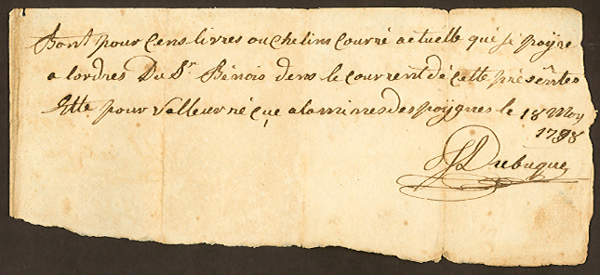
Despite his business successes, Dubuque was almost constantly in debt from 1803 until his death. A generous man, Dubuque supported many people who worked at his mines. He also lived in an unusually fashionable manner for life on the frontier of those years. Dubuque enjoyed the services of Patrice Roy and Josette Anyette as servants. At the time of his death, an inventory of his possessions included expensive household items and fifty-eight books including eight volumes of political science and the works of Montesquieu.
The question of Dubuque's marital status continues to be unresolved. In personal letters, Dubuque referred to a "Madam Dubuque." He is believed to have married POTOSA, the daughter of Chief PEOSTA. The fact that no mention of a wife was made during the settling of his estate has been used to suggest a wife, if one existed, was a Native American who may have simply gone back to her tribe.
In the last years of his life, Dubuque often suffered from severe illness. Twice his death was reported by Native Americans. (16) It is believed he died of pneumonia. On the day of his funeral, legends state that a sorrowful procession carried his body to his grave. Celebrated chiefs were said to have argued for the honor of carrying his remains. All of this, of course, was verbally reported including the story that a lamp was kept burning on his grave for many years. It is known that fifteen years after his death, a cedar cross was placed on the site by some French-Canadians. (17)
Upon his death, Dubuque was buried by his Native American friends on a bluff high above CATFISH CREEK overlooking the Mississippi River. His grave was covered with a wooden and stone shelter complete with a gable roof and open window through which Native Americans believed the soul of the departed could leave. It was reported in an article published in 1945 that James LANGWORTHY discovered the body when he returned to this area in 1833. According to the report, Langworthy found the body in a cabin near the river with a "pipe thrust between his teeth and his body adorned andn surrounded by the various implements after the usual manner of Indian burials. (18) At the apex of the cabin was a wooden cross made by white friends. The stone building was still intact in 1845. (19)
In 1967 a document in Julien Dubuque's handwriting was added to the rare volume and documents collection in the Wahlert Library at LORAS COLLEGE. The note read: (20)
I, Julien Dubuque, recognizing owing to Messers. Faither (H or et)
Bre' Brisebois and Coponier the sum of 6288.15 pounds (Sols) in
money or pelts payable to Makinas guaranteeing that next August the
pelts will be there totaling before their departure from this post.
Done in good faith at Prairie du Chien the 30th of October, 1809.
Julien Dubuque
A recurrent question has been whether Dubuque left a will. In 1891 a relative in France wrote the following letter to Iowa Governor Boies: (21)
Paris, June 25, 1891
Monsieur Le Gouverneur: I have the honor to beg you to
have the goodness to let me know if my grand-uncle
Monsieur Jean Pierre Dubuque, who has founded the city
of Dubuque, where he managed [the] County Bank, has
left a will or any other document in favor of his family.
I should wish to know what attorney or what magistrate
fixed his last affairs and what would be about the fortune
he left.
M. Dubuque was born in Amance, Upper Saone, France, and it
would seem that one of his nephews, Gabriel Dubuque [a]
French priest, went to join him and assisted him in his
last moments.
Not knowing anything further I cannot give you any more
details. This is the reason why I would be very grateful
if you would honor me with an answer that could give me
all the information that I take the liberty of asking from
you. In expecting it I beg of you, Monsieur Gouverneur,
to receive my most respectful salutations.
Germain Denis
True Francois Henry, an pre St. Gervais, Sein
To M, le Gouverneur de l'Etat d'Iowa (Etats Unis)
Although there was an inventory of Dubuque's property in his home, there was no mention of a will.
For many years it was believed that Julien Dubuque was the first white settler in the future state of Iowa. In 1929 documentary proof that this was probably not the case was announced by Edgar R. Harlan, curator of the State Historical Society of Iowa. According to records, Basil Giard, the man Dubuque later rescued, arrived several years before Dubuque.
The physical appearance of Julien Dubuque has continued to intrigue historians. (22) In 2012, members of the DUBUQUE COUNTY HISTORICAL SOCIETY and curators at the National Mississippi River Museum asked forensic artist Karen T. Taylor to create a facial reconstruction based on the skull of Julien Dubuque. In the late 1800s, excellent photographs were made of Dubuque's skull prior to reburial. Although Dubuque's actual skull now lies buried under many feet of concrete, Taylor was able to use the multiple 1887 photographs, along with historic and anthropological inputs to create a reasonable depiction of his appearance in life. The facial reconstruction images are on display the National Mississippi River Museum and Aquarium. (23)
The spelling of Dubuque was settled in 1950 with the visit of Guy Francois Dubuc, a great, great, grand nephew of Julien. Rt. Rev. Mathias M. HOFFMAN, a respected historian, had stated that Dubuque was a common variation in Canada. The name could have been spelled Dubuque, DuBuque, or Dubuc. Guy Dubuc brought with him a copy of the church register from St. Pierre les Becquets, Julien Dubuque's birthplace. The community is located on the St. Lawrence River about one hundred miles northeast of Montreal. The document, signed by J. Hingan, read:
On January 10, 1762, was baptized by our
priest of St. Pierre, Julien Dubuc, born
today of the legal marriage of Augustin
and Marie Mailhot. Witnesses were Amant
Guilhaut and and Marie Angelique Tessier
who have signed that they do not know how
to sign their names. (24)
See: ROLLING CLOUD
See: LA PETITE NUIT
---
Source:
1. Hudson, David; Bergman, Marvin; Horton, Loren. The Biographical Dictionary of Iowa. Iowa City: University of Iowa Press, 2008, p. 139
2. Ibid.
3. Hudson, p. 139
4. Houlette, William. Iowa: The Pioneer Heritage. Des Moines: Wallace-Homestead Book Company, 1970, p. 206
5. "Iowa: Its History and Foremost Citizens-Julien Dubuque," Iowa History Project. http://iagenweb.org/history/IHFC/IHFCBk1Pt1Chp1-2Bio.htm
6. "The City of Dubuque," Southern Sentinel, October 10, 1849, p. 1. Online: http://chroniclingamerica.loc.gov/lccn/sn88064476/1849-10-10/ed-1/seq-1/#date1=1849&index=0&rows=20&words=Dubuque&searchType=basic&sequence=0&state=&date2=1849&proxtext=dubuque&y=10&x=8&dateFilterType=yearRange&page=1
7. Hudson, p. 139
8. "Iowa: Its History and Foremost Citizens-Julien Dubuque," http://iagenweb.org/history/IHFC/IHFCBk1Pt1Chp1-2Bio.htm
9. Hudson, p. 139
10. "Julien Dubuque Rescued Trapper," Telegraph Herald, Feb. 2, 1927, p. 5. Online: http://news.google.com/newspapers?id=pXFFAAAAIBAJ&sjid=mbwMAAAAIBAJ&pg=5167,34772&dq=julien+dubuque&hl=en
11. Moeller, Hubert L. "Dubuque, Iowa's First Landowner," The Des Moines Register, Sept. 18, 1933
12. "Major Zebulon Pike Tries to Interview Julien Dubuque, 1805," http://www.wisconsinhistory.org/turningpoints/search.asp?id=906
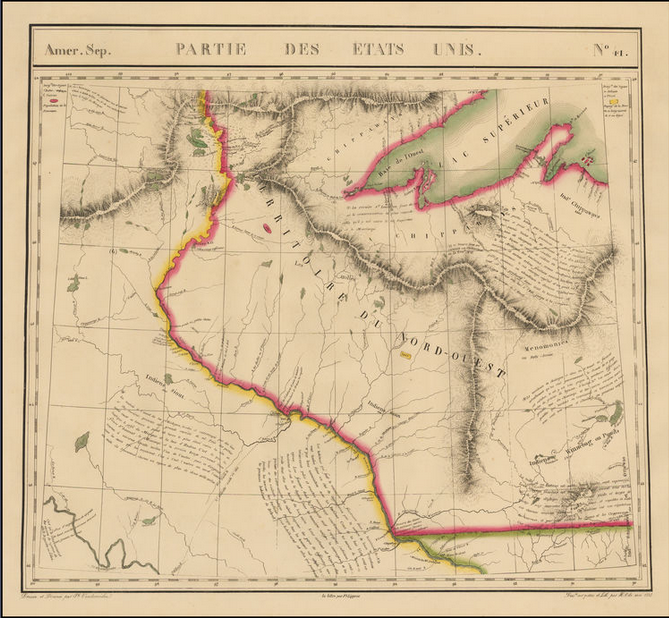
13. Houlette, William. Iowa: The Pioneer Heritage, Des Moines: Wallace-Homestead Book Company, 1970, p. 207
14. Evans, Mary Ellen. "Under Five Flags: Julien Dubuque, Miner of the Mines of Spain," Telegraph Herald, May 27, 1938, p. 14. Online: http://news.google.com/newspapers?id=WfhBAAAAIBAJ&sjid=SqoMAAAAIBAJ&pg=4819,3120828&dq=mining+dubuque&hl=en
15. Ibid.
16. Bourbeau, Bud. "Body Interred in Bluff in Tribal Dignity, Honor," Telegraph Herald, August 16, 1958, p. 28
17. Ibid.
18. "Old Mansion is Doomed," Telegraph-Herald, March 25, 1945, p. 3
19. "New 'Heirs' to Julien Dubuque Fortune Appear," Telegraph Herald and Times Journal, Feb. 19, 1935, p. 12. Online: http://news.google.com/newspapers?id=MdZBAAAAIBAJ&sjid=9KkMAAAAIBAJ&pg=6237,2114839&dq=julien+dubuque&hl=en
20. "Plans Ready for Julien Dubuque Park," Telegraph Herald, Feb. 7, 1963, p. 28. Online: http://news.google.com/newspapers?id=Y49FAAAAIBAJ&sjid=5bwMAAAAIBAJ&pg=3194,4156713&dq=julien+dubuque&hl=en
21. "A Julien Dubuque Document," Telegraph Herald, Oct. 2, 1967, p. 1. Online: http://news.google.com/newspapers?id=cwdRAAAAIBAJ&sjid=xsAMAAAAIBAJ&pg=4360,272280&dq=julien+dubuque&hl=en
22. "Claim Julien Dubuque Wasn't First White Settler in Iowa," Telegraph Herald and Times Journal, Mar. 24, 1929, p. 29. Online: http://news.google.com/newspapers?id=44lFAAAAIBAJ&sjid=sbwMAAAAIBAJ&pg=5535,6884750&dq=julien+dubuque&hl=en
23. "Picture of Julien Dubuque," Telegraph Herald, Aug. 11,, 1907, p. 3. Online: http://news.google.com/newspapers?id=vetCAAAAIBAJ&sjid=56sMAAAAIBAJ&pg=3382,1364695&dq=julien+dubuque&hl=en
24. "Dubuc Visits Dubuque of His Kinsman Julien," Telegraph Herald, March 23, 1950, p. 1. Online: https://news.google.com/newspapers?nid=aEyKTaVlRPYC&dat=19500323&printsec=frontpage&hl=en



